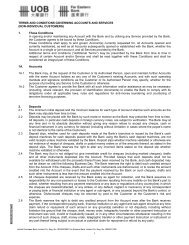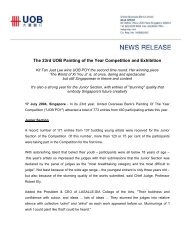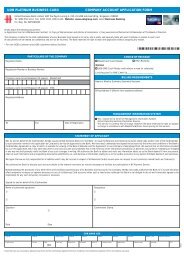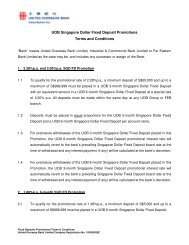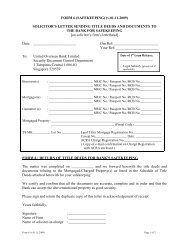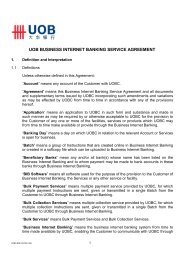UOB Annual Report 2002 - United Overseas Bank
UOB Annual Report 2002 - United Overseas Bank
UOB Annual Report 2002 - United Overseas Bank
Create successful ePaper yourself
Turn your PDF publications into a flip-book with our unique Google optimized e-Paper software.
Risk Management<br />
The management of liquidity risk is carried out throughout the year by a combination of cash flow<br />
management, maintenance of high quality marketable securities and other short-term investments<br />
that can be readily converted to cash, diversification of the funding base, and proactive management<br />
of the Group's 'core deposits'. 'Core deposits' is a major source of liquidity for the Group. These<br />
'core deposits' are generally stable non-bank deposits, like current accounts, savings accounts and<br />
fixed deposits. The Group monitors the stability of its 'core deposits' by analysing their volatility<br />
over time.<br />
In accordance with the regulatory liquidity risk management framework, liquidity risk is measured<br />
and managed on a projected cash flow basis. The Group is required to monitor liquidity under<br />
'business as usual' and ‘bank-specific crisis' scenarios. Liquidity cash flow mismatch limits have<br />
been established to limit the Group’s liquidity exposure. The Group has also identified certain early<br />
warning indicators and established the trigger points for possible contingency situations. These<br />
early warning indicators are monitored closely so that immediate actions can be taken. On a<br />
tactical daily liquidity management level, Global Treasury – Asset Liability Management Unit is<br />
responsible for effectively managing the overall liquidity cash flows in accordance with the Group's<br />
approved liquidity risk management policies and limits.<br />
Liquidity contingency funding plans have been drawn up to ensure that alternative funding<br />
strategies are in place and can be implemented on a timely basis to minimise the liquidity<br />
risks that may arise upon the occurrence of a dramatic change in market conditions. Under the<br />
plans, a team comprising senior management and representatives from all relevant units will direct<br />
the business units to take specified actions to create liquidity and continuous funding for the<br />
Group's operations.<br />
<strong>Overseas</strong> banking branches and subsidiaries must comply with the regulatory requirements with<br />
regards to liquidity and will operate on being self-sufficient in funding capabilities, whenever<br />
possible. However, the Group’s Head Office in Singapore will provide funding to them on an<br />
exceptional basis, for instance, during a stressed liquidity crisis when they are unable to borrow<br />
sufficient funds for their operational needs or when it is cheaper to fund through Head Office.<br />
The table in Note 44(d) to the Financial Statements shows the maturity mismatch analysis of<br />
the Group's nearer and longer-term time bands relating to the cash inflows and outflows based<br />
on contractual classifications arising from business activities. The projected net cash outflow<br />
in the 'Up to 7 Days' time band comprises mainly customers' current accounts and savings<br />
accounts that are repayable on demand. However, when these customer deposits are adjusted<br />
for behavioural characteristics, the projected net cash outflow in the 'Up to 7 Days' time band is<br />
very much reduced as they are adjusted out to the longer-term time bands due to the stable nature<br />
of these customer deposits.<br />
42




